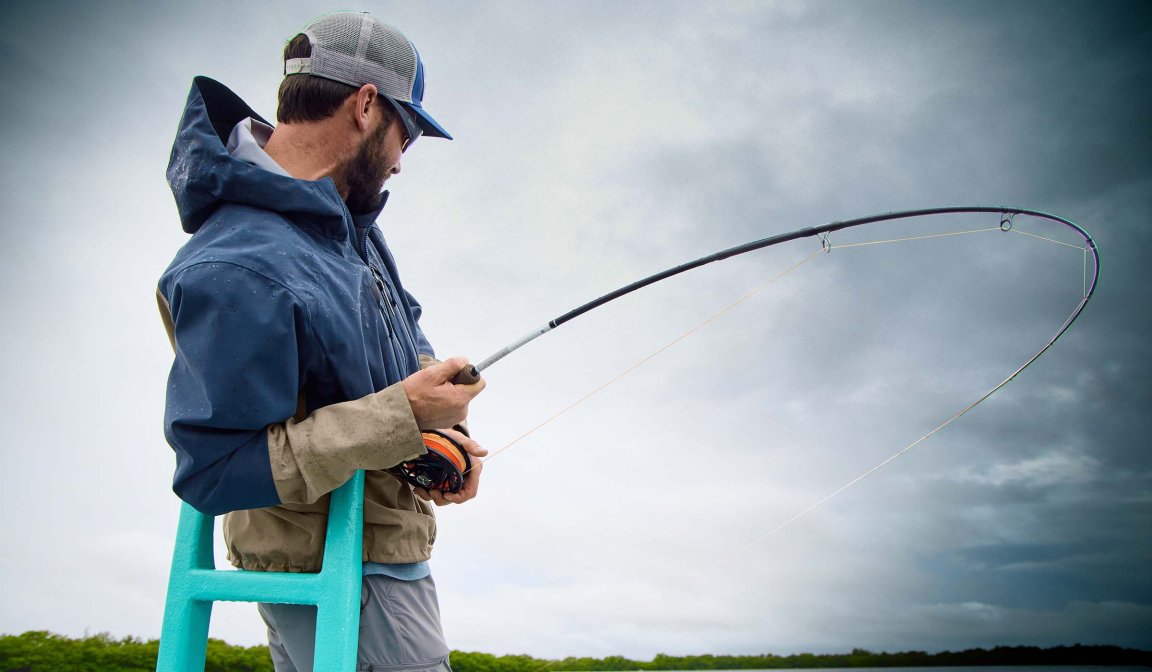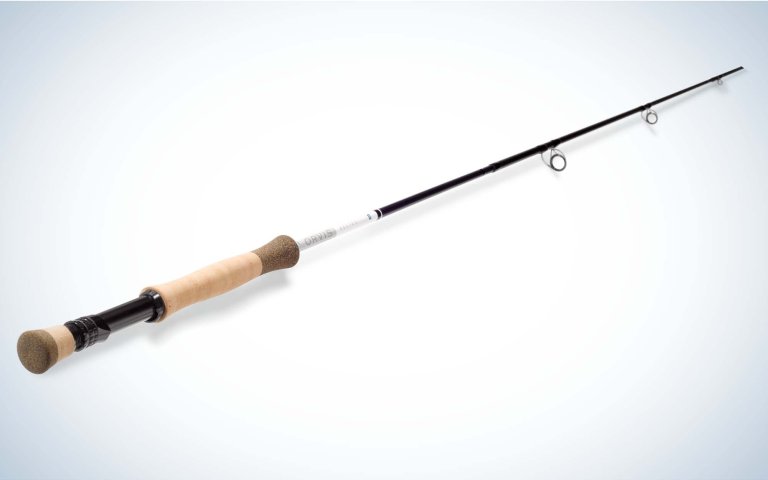We may earn revenue from the products available on this page and participate in affiliate programs. Learn More ›
The Orvis Helios 3 is one of my favorite rods for throwing everything from bugs to giant streamers. I caught my first musky on an 11-weight 3D, so that signature white label and blue-highlighted 3D will always be special to me. But after seven years it might be time to put down the old sticks in favor of the new Helios.
Orvis’ new line of rods isn’t called the Helios 4; it’s just called the Helios. I guess like Drake, Seal, and Rosenbauer, it got famous enough that it only needs one name now. It comes in 29 models, from small stream to big game rods. I got my hands on an 8-weight a few days before the launch and put it through a casting test. I also interviewed Orvis’ director of product design and development, Shawn Combs, to learn what went into engineering the new rod line.
Helios Specs and Features
- 29 models (8-weight Helios D tested)
- Two Rod Families: Distance and Finesse
- Finesse has 2- to 8-weight rods
- Distance has 4- to 14-weight rods
- Made in the USA
- MSRP: $1098-$1198
Casting the Orvis Helios

Orvis says the Helios is four times more accurate than the Helios 3 as well as more accurate than the competition (more on that later). I’m skeptical of bold claims like that from a manufacturer because, all too often, they end up being a marketing strategy rather than product innovation. Yet, I contained my skepticism until after I put the Helios through the same casting test done for the Best Saltwater Fly Rods.
Accuracy


I cast to 30-by-20-inch targets at 45 and 60 feet. Three testers took five shots at each distance at the fly rod test, but I was solo for this review and took 15 shots at both targets. I didn’t miss at 45 and missed once at 60 feet. I’m not usually that good, and it’s been a long winter.
I then grabbed my trusty Scott Sector for comparison and hit the 60-foot target 12 times, which is more on par with what I’m used to. Not satisfied that I’m actually a good enough caster to go 14 for 15 at 60 feet, I kept casting the Helios to see if I could induce misses by making common mistakes. I tried to overpower the rod, and it was still accurate. I tried casting big loops, and it was still accurate. Any cast that wasn’t a tailing loop landed on or very close to the 60-foot target.
At the fly rod test, the Helios 3D scored a 4.5 out of 5 for accuracy, and it produced the most consistent long casts. Not surprisingly, it was among the best rods we tested. But, I do think the new Helios is more accurate and more forgiving. I can’t quantify if it’s four times better with a simple casting test, but you can certainly feel that it’s more stable and easier to cast well.


Distance
At our rod test we get five tries to bomb a cast and measure the longest. I couldn’t muster a 90 footer and had to settle for 74 feet with the weight forward floating line. It’s worth noting all five of my casts were over 70 feet. That’s pretty consistent to what I’ve seen in rod testing. Rods don’t typically add feet to your longest cast, but the good ones help you consistently hit your max potential.
Ease of Casting
I think the biggest strength of the Helios is that it makes fly casting easier. I found that when I messed up a cast it still went pretty far, and it was still accurate. I also did a lot of backhand casting and the Helios was still a laser beam. Then, I replicated needing to quickly change casting directions as well as picking up a cast and shooting with one haul. The Helios remained consistent through all of it.
Putting that into a fishing context, when you’re exhausted at the end of an eight-hour day and your form is no longer crisp, the Helios helps you land a fly on a fish’s nose.
The New Design

So maybe Orvis’ performance claims aren’t all marketing, and they actually found a way to better an already amazing rod. How’d they do it?
How They Made it Accurate
Combs says they started by building testing equipment that would objectively measure fly rod accuracy.
“We would refer to it as dampometer, which is really an infrared camera and machine vision device that measures the displacement of a fly rod’s tip in a laboratory,” says Combs.
They place an IR glow dot on the tip of a fly rod, and they record the tip’s movement using a camera that records IR light. All they see is the glowing dot on a black screen. What they’re looking for is how much that dot moves around and the direction of its movement. The goal is to build a rod that has very little oscillation.

“A perfect example of a super accurate tracking fly rod would be that when you cast it has no lateral movement with regards to the direction of your target, and all the energy is going into putting the fly line to that target as efficiently as possible,” Combs says.
With those recordings, they were able to test prototypes and compare them with fly rods from previous generations.
“A Helios 3 would track left and right, a total threshold of 1.6 to 2 inches depending on the model,” Combs says. “And we’re down now to 0.4 [inches], which is about the width of a tip-top guide.”
As a gear editor, I’m curious about how I can get my hands on one of those fly rod testers. But I’m sure you’re more interested in how they built a blank that dramatically reduced oscillation.
“We’ve really focused on hoop strength, which is the resistance to ovalization of the cross section of this thin tube during the casting energy transfer of load and unload,” says Combs.
He used the analogy of bending a straw. It will flatten out and become an oval then buckle. A fly rod can do that too, which causes your fly line to shoot slightly left on one cast or slightly right on another. In addition to your fly line releasing in an unpredictable direction, the ovalization robs energy.
Developing the Helios Rod Design

Combs says they began advanced concept work on the Helios in 2020, and he was already catching fish on it that summer. The following year they had field testing prototypes ready. That’s incredibly fast product development, but it wasn’t without its challenges.
“It’s really challenging to achieve a softness that you would want in a small stream 2 or 3 weight or 4-weight for that matter in a short rod,” Combs says. A soft rod that still tracks well for surgical precision is one challenge, but so was designing a versatile big game rod that can throw long leaders for laid-up tarpon and giant musky flies.
“You try to make them so there are no compromises at all,” says Combs. That’s sounds like telemarketing, right? But legitimately, one of the coolest things about the Helios line is we’ve got these complex springs that we put cork, guides, and reel seats on. We’ve developed them in a way that when they have the same displacement value, regardless of how much you load them. So they are very adaptive to different line setups, fly setups, fishing scenarios, and casting styles.”
Durability

In addition to being more accurate than the Helios 3, Orvis says the new rods are more durable. Combs says the key to increasing durability was in the blank material, including patented proprietary thermoplastic resins. He said it was a matter of finding a blank that casts well, trying to break it, and then refining the construction again.
Recommended Rods
I ended my interview with Combs by asking him to pick his favorite of the 29 rods. Naturally, he gave me his five favorites.
- Dry Fly Rod: 9-foot, 5-weight Helios F
- Streamer Rod for Trout and Smallies: 8-foot, 5-inch, 7-weight Helios D
- Big Game Rod: 9-foot, 10-weight Helios D
- Everglades Rod: 8-foot, 5-inch, 10-weight Helios D
- Do Everything Trout Rod: 9-foot, 5-inch, 5 weight Helios D
The Upshot
In my short time with the Helios I can safely say that it is an improvement over the Helios 3D. It’s certainly worth trying one at a dealer to see if you like it. The accuracy is impressive, as is the overall low swing weight and ease of casting. Will it achieve the legendary status of its predecessor? Ask me again in seven years.

